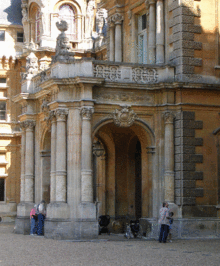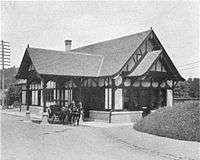Porte-cochère


A porte-cochère (/ˌpɔːrt koʊˈʃɛr/), coach gate or carriage porch is a porch- or portico-like structure at a main or secondary entrance to a building through which a horse and carriage (or motor vehicle) can pass in order for the occupants to alight under cover, protected from the weather.
In modern usage, portes-cochère are still used on some types of buildings such as major public buildings and hotels, where they provide pick-up and drop-off space, for example for dignitaries, taxis and buses. [1]
History
The porte-cochère was a feature of many late 18th- and 19th-century mansions and public buildings. Well-known examples are at Buckingham Palace in London and at the White House in Washington, D.C. [2]
Today a porte-cochère is often constructed at the entrance to public buildings such as churches, hotels, health facilities, homes, and schools where people are delivered by other drivers. Portes-cochère differ from carports in which vehicles are parked; at a porte-cochère the vehicle can pass through, stopping for passengers to board or alight.
At the foot of the porte-cochère there are often guard stones, which act as protective bollards to prevent vehicles from damaging the structure.
Gallery
- The Lockwood–Mathews Mansion, built in 1864
 The Briarcliff Lodge, built in 1902
The Briarcliff Lodge, built in 1902 The Briarcliff Manor railroad station, built in 1906
The Briarcliff Manor railroad station, built in 1906 A typical railway porte-cochere at Nottingham station
A typical railway porte-cochere at Nottingham station
References
- ↑ "Top 10 Design Tips to Dazzle Your Guests: The Porte Cochere". HKS Architecture. Retrieved 2015-06-18.
- ↑ "Shoptalk: Porte-Cochère". Treanor Architects. Retrieved 2015-09-18.
External links
| Wikimedia Commons has media related to Portes-cochères. |
| Look up porte cochère in Wiktionary, the free dictionary. |